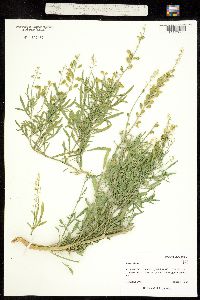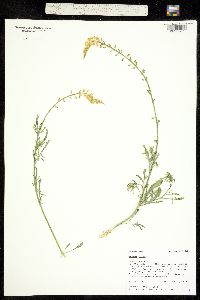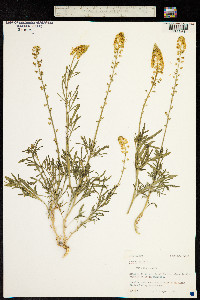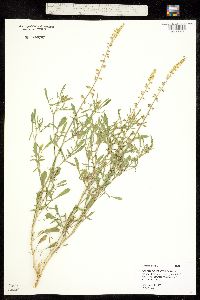Reseda lutea
|
|
|
|
Family: Resedaceae
Yellow Upright Mignonette
[Reseda lutea var. vivantii] |
Plants annual or perennial, 30-80 cm, glabrous, papillose-scabrid, or hirtellous. Stems erect or ascendent, branched. Leaves: blade obovate, 4-10 × 1-2.5 cm, margins entire or ternately to biternately lobed (lobes 1-3 pairs, narrow-oblong or lanceolate-linear, margins flat or repand), surfaces scabrous or glabrous. Racemes 10-20(-50) cm; bracts caducous, oblong-linear, 2-4 mm. Pedicels 3-7 mm. Flowers (rarely polygamous); sepals persistent or tardily deciduous, (5-)6, not reflexed in fruit, linear-oblong, 3-4 mm; petals (5-)6, yellow, 2-5 mm, rounded-clawed, adaxial ones trisect, lateral lobes semilunate or falcate, margins entire or incised; stamens (12-)14-18; filaments deciduous, 1.5-3 mm, scabrid-papillose; intrastaminal nectary-discs pilose; anthers 0.9-1.5 mm; placenta entire. Capsules usually erect, 3-carpelled, cylindric or ovoid to subglobose, 7-15 × 4-6 mm, apically 3-toothed, glabrous or papillose, ribs scabrid. Seeds 1.4-2 mm, glossy, smooth (carunculate). 2n = 48. Flowering (Apr-)May-Sep. Grasslands, pastures, gravelly or shaley slopes, railroads, roadsides, mortared crevices in stone walls, disturbed areas, ballast ground, agricultural fields, usually on basic soils; 0-1500 (-2500) m; introduced; B.C., Man., Ont., Sask.; Ala., Ark., Calif., Colo., Conn., D.C., Iowa, Kans., Ky., Maine, Md., Mass., Mich., Mo., Mont., Nebr., N.H., N.J., N.Y., Ohio, Oreg., Pa., R.I., Utah, Vt., W.Va., Wis., Wyo.; Europe; sw Asia; n Africa; introduced also in South America, c Asia, s Africa, Australia. In Australia, Reseda lutea is considered an invasive introduction that causes damage to crops; research is being carried on for means to control its expansion. It has been used as a dye plant, to a lesser extent than R. luteola. It has been found to have antibacterial activity against some pathogens. There is also potential utility for phytoremediation in soils contaminated with copper.
Biennial or perennial herb to 0.8 m tall Stem: erect or ascending, branching. Leaves: alternate, 5 - 10 cm long, irregularly pinnate-divided or sometimes divided a second time (bipinnatifid). Flowers: borne in a dense terminal infloresecence (raceme) to 20 cm long, greenish yellow, small, with six sepals and six unequal petals, the uppermost petal largest and the others progressively smaller, each petal deeply two- or three-lobed at tip. The stamens are born twelve to twenty on a fleshy disk and are clustered on one side of the flower, and the ovary is three-lobed at the tip. Fruit: an egg-shaped to cylindrical capsule, 6 - 12 mm long, 4.5 - 5.5 mm across, with a three-lobed tip that opens at maturity, containing blackish kidney-shaped seeds. Similar species: Reseda luteola and Reseda odorata lack deeply divided leaves and have capsules that are nearly spherical. Reseda alba has evenly divided leaves, a four-lobed capsule with persistent filaments, and greenish white flowers with ten to fifteen stamens. Flowering: summer Habitat and ecology: Introduced from Europe, this species is rare in the Chicago Region but grows in some waste places. Occurence in the Chicago region: non-native Etymology: Reseda comes from the Latin word resedo, meaning "to heal." Lutea means yellow. Author: The Morton Arboretum Erect or ascending, diffusely branched, taprooted biennial or perennial to 8 dm, glabrous; lvs irregularly pinnatifid, with a few narrow, entire or cleft lateral segments chiefly near or above the middle; fls greenish-yellow; pet usually 6, with appendages as in no. 1[Reseda alba L.]; filaments deciduous; ovary and fr usually with 3 apical lobes; 2n=48. Waste places, N. Engl. to Io., Mo., and Md.; intr. from Europe. Gleason, Henry A. & Cronquist, Arthur J. 1991. Manual of vascular plants of northeastern United States and adjacent Canada. lxxv + 910 pp. ©The New York Botanical Garden. All rights reserved. Used by permission. |


























































































